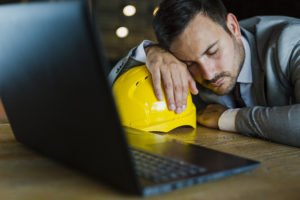SHP hears from Heather Beach, Founder of Healthy Work Company about mental health and wellbeing being integrated into safety from a risk-based point of view…

Heather Beach, Founder of the Healthy Work Company
My ambition in building Healthy Work Company was that we would support a risk-based approach to the integration of mental health and wellbeing into the role of the health and safety professional.
Five years on and what I notice is huge progress in the workplace and even among male dominated sites (much to the disgust of the UK Daily Mail) in openness about our own struggles; in “bringing our whole selves to work”; in de-stigmatising mental illness; in asking each other how we are really.
That is truly ground to be proud of and move forward from.
But what I am wondering is, whilst this represents progress for humanity, were we clear on what problem we were trying to solve and have we started to solve it?
Let’s take Mental Health First Aid, the most common mental health initiative from health and safety professionals utilised in the UK. The evidence shows that the course makes a difference to the participants, in educating them and in de-stigmatising mental ill health. It has (I believe) made a huge difference to that “openness” discussed above; but has it helped reduce accidents or suicides, mental health related sickness absence, stress in the workplace or created a happier, healthier workforce?
Were these even the problems we were trying to solve by its introduction or had we not articulated those?
Five years post the first Healthy Work conference in 2017 for health and safety professionals on integrating “mental health” into their roles and we are ALL still learning:
- There has been a huge lack of understanding that it is an organisational not an individual stress risk assessment which is a requirement under HSAW etc 1974 – and as well as real organisational reluctance to “open that particular can of worms”, a lack of confidence from the profession in creating one
- In 2021 we ran a survey which showed that 92% of organisations indeed had a wellbeing strategy. But only 29% had trained and involved their board in this. I will go out on a limb here and say that without the involvement of the senior team in defining what kind of organisation you want to create and what you want to do and not do as a result of that, you just have a series of tactics
- A growth in the hiring of wellbeing managers without the necessary seniority to make a real difference to the organisation’s functioning
- Sometimes a bunfight between health and safety and HR as to who “owns” mental health and wellbeing, without the understanding that this is a place where they intersect
- In regards to the tactics, health and safety often only “own” MHFA training – which sits fairly low down on the hierarchy of risk control
- There is confusion over the distinctions between terms. Particularly on the differences between psychological safety, and psychosocial risk
ISO45003 like all standards, ensures senior management buy in. It differs from ISO45001 in the detail it goes into about psychosocial risk. And you need senior manager wellbeing stakeholders just like you need them for safety.
We now also have an increased focus from HSE on stress risk management – both from a guidance and enforcement perspective.
During the pandemic, due to the urgency of the mental health crises provoked by uncertainty and lockdown, both HR and Health and Safety were necessarily tactical with training and benefit initiatives but with the introduction of ISO45003, perhaps professionals are now asking themselves the question: What problem are we trying to solve?
Building mental health and wellbeing INTO safety?
If we focus purely on hazards when we look at risk control, we ignore at our peril the psychological and organisational factors where applying traditional controls don’t work. We know that fatigue is a major contributory factor to accidents (and major disasters) but what does the data show about mental illness and mental distress?
In 2006 the Keil Centre examined the link between psychological ill health, anxiety, depression and safety and concluded (as we all intuitively know) that all can interfere with an individual’s performance.
 It is no surprise that the impact of mental distress, stress, depression, anxiety or other mental illness will have an impact on an individual’s level of distraction, cognition, attention.
It is no surprise that the impact of mental distress, stress, depression, anxiety or other mental illness will have an impact on an individual’s level of distraction, cognition, attention.
Even stronger evidence they found, exists for “frame of mind”. “The way people are thinking and feeling can cause or contribute to them having an accident, behaving unsafely or committing an error”. This morning I had a conversation with a colleague in the industry who was discussing an incident in which “frustration” was a key contributory cause.
A study of the airline industry in the Netherlands in 2013 established that Pilot mental disorders were believed to have played a part in 17 accidents and incidents over the past 35 years, including nine fatal accidents that resulted in 576 deaths. The fatal accidents were related primarily to the pilot’s difficulty coping with “negative life events” such as relationship problems, legal problems and work-related stress”.
EU regulations were finally introduced in 2021 which include a mandatory psychological assessment for pilots before being hired, drug and alcohol testing, and mental health support.
A Swedish study in 2013 (NOT of the workplace but of a large cohort) also found “people with mental disorders had a highly increased risk of accidental death – which was substantially more common than suicide. Mental disorders overall were associated with a 5.3-fold risk of accidental death among women and a 6.6-fold risk among men.”
We have already accepted and attempt to mitigate the impact of fatigue, drugs and alcohol, violence and harassment at work. Is it too big a stretch to start to consider burnout, bullying managers, a culture of performance at all costs, lack of perceived justice, micro-management, poor pay and conditions and worry about finances (just as some examples)?
As health and safety professionals we can’t do this alone, just as we can’t do any aspect of health and safety management effectively, alone.
And is it truly a distraction to our “main job” of accident and ill health prevention or could it be a game changer?
Why psychosocial risk is easier to discover than you think
To all those organisations who tremble at the thought of stress risk assessment perhaps you just need to change your vocabulary internally for I am sure you already do a HR Engagement survey. In fact, most of the answers you seek to what the key stress risk factors are for work in your organisation are already held in that document.
The HSE management standards take you through the main workplace challenges which cause stress and ISO 45003 takes you further, but where I don’t agree with this approach entirely is that it ignores the personal.
Ultimately, does it make a difference to the impact on the workplace (accident/long-term sickness absence) whether the issue is work-related or personal – we still have to address the result? Often disentangling the personal stressors from the professional are very difficult to do. In my last job, the last stress/anxiety case I handled was someone who I had promoted without providing adequate support (so yes a workplace issue) but…he also had two children under two years old at home, his wife had just gone back to work, they had no family support and he was exhausted.
These days I would ask better questions.
I also think you should look at your demographics. How many of your workforce will be impacted by worry about the financial crisis, are struggling with relationship issues or grief, or are perhaps dealing directly or indirectly with the menopause?
I have now run several sessions with exec teams working in partnership with both HR and H&S to look at the top stress risks for their organisation and then narrowed that down to the biggest issues. When it comes to mitigation, sometimes there is a quick win. Sometimes there are some wicked problems which need a further session to tease out some possible solutions.
Sometimes we get stuck in performance is the only goal or our workplaces lack adult to adult conversation about priorities
Your senior team
 Your organisational wellbeing strategy needs to be the purview of a senior team for two reasons.
Your organisational wellbeing strategy needs to be the purview of a senior team for two reasons.
Firstly, role modelling is crucial. If culture is “the way things are done around here” and your senior team never take holidays or lunch breaks, lose their temper, are generally unhealthy and always tired then that is the way things are done around here…
Secondly, if one of your key stress risk factors is that in truth your organisation is about workload or job roles or management of change for example, then your senior team have some decisions to make.
Your wellbeing strategy
Your wellbeing strategy should look at organisational stress risk factors, education and training, hiring, induction, performance management, manager behaviours as well as benefits and tertiary interventions such as MHFA/Employee Assistance Programmes/Occupational health. Obviously, some of this sits with HR.
As well as an organisational wellbeing strategy which can be the purview of a senior team (including HR and H&S), consider building wellbeing into your safety strategy, not just retrospectively looking at its role in accident causation. When you are looking at the key hazards for a task or project can you also look at the key wellbeing factors which may interfere with the safe execution from a human perspective?
Individual vs organisational responsibility and the role of better questions
In spite of HSE, WHO etc seeming to ignore the role of the individual and the personal in wellbeing at work I don’t think we can. Let’s take burnout as a great example which ICD11 sees as an occupational condition and is generally considered to be the fault of a toxic workplace.
I have indeed suffered from burnout myself.
I was working, at the time, for none other than myself.
I identified that I had several characteristics which mean I am predisposed to it. I am a (recovering) perfectionist, a people pleaser with high self-efficacy who gets not only great energy from learning and working, but can also overdo it.
I need to know this about myself. I need to educate my manager about this (if I ever have one again) and don’t want to work for an organisation which encourages it through organisational practices such as expecting out of hours working, routinely giving too much work to do and where failure or mistakes are punished. Yes, that workplace has a responsibility to function better, but I need to know myself too. Organisations can also support by providing education in self-awareness and knowledge of aspects of wellbeing.
We need to ask ourselves better questions.
Am I fit for this task? Have I had enough sleep or am I too agitated or distracted to do this safely?
Train your managers to ask better questions of teams – are you OK to perform this task today? Have you driven too far and need a break? Did you have enough sleep? And then the role of psychological safety comes in, because it needs to be OK to say I am not fit today actually, no.
A useful tool to start this conversation is MIND’s Wellness Action Plans which are a bit like a proactive individual stress risk assessment.
In summary
The WHO said that the increase of anxiety and depression through Covid was c.25%. Whilst the UCL longitudinal study has shown that some sections of the population have as you might expect, adapted and shown resilience, many demographic groups have not. Mental health issues are at the moment a key feature of working life, underpinned by inequalities in society and many of the unhealthy, unforeseen consequences of progress. Whilst we can’t as health and safety professionals address society at large, let’s at least address working practices which contribute to stress in our organisations rather than just signposting to help when they are already struggling.
Heather Beach is the founder of Healthy Work Company which works with 100 UK and global brands in supporting wellbeing strategy and training. From Board sessions on ISO45003 to Manager training in wellbeing conversations, to stress risk assessment support, Heather is a key influencer in the sector. Healthy Work Company is running a one day open course on developing wellbeing strategy through stress risk assessment, click here to register.
What makes us susceptible to burnout?
In this episode of the Safety & Health Podcast, ‘Burnout, stress and being human’, Heather Beach is joined by Stacy Thomson to discuss burnout, perfectionism and how to deal with burnout as an individual, as management and as an organisation.
We provide an insight on how to tackle burnout and why mental health is such a taboo subject, particularly in the workplace.


 It is no surprise that the impact of mental distress, stress, depression, anxiety or other mental illness will have an impact on an individual’s level of distraction, cognition, attention.
It is no surprise that the impact of mental distress, stress, depression, anxiety or other mental illness will have an impact on an individual’s level of distraction, cognition, attention. Your organisational wellbeing strategy needs to be the purview of a senior team for two reasons.
Your organisational wellbeing strategy needs to be the purview of a senior team for two reasons.